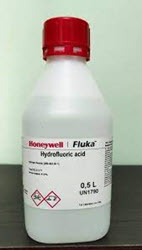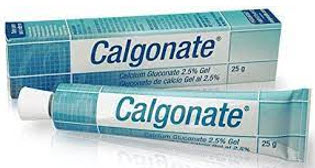Hydrofluoric acid
And other hydrogen fluoride releasing chemicals
Hydrofluoric acid (HF) is a clear, colorless, inorganic acid that is used in research and industry for its ability to etch glass, metal and silicon compounds. It is also an essential tool for semiconductor and electronic fabrication and mineral processing. Despite its useful properties, exposure to HF poses severe health risks. This can result in tissue necrosis and amputations, imbalances of sodium and magnesium levels in the body, and can ultimately be fatal. Best management practices must be reviewed and continually employed while working with this chemical.
 Other fluorine-containing compounds can pose similar health hazards resulting in HF exposure.
Other fluorine-containing compounds can pose similar health hazards resulting in HF exposure.
These chemicals include but are not limited to:
Buffered Oxide Etchant (BOE) – comprised of HF and a buffering agent like ammonium fluoride
Fluoroboric acid (HBF4)
Hydrogen fluoride pyridine
Kroll’s Reagent (Solution containing HF and HNO3)
Lithium hexafluorophosphate (LiPF6)
What Makes HF So Dangerous?
Unlike other inorganic acids like hydrochloric (HCl), sulfuric (H2SO4), nitric (HNO3), or phosphoric (H3PO4) acid, hydrofluoric (HF) acid is highly lipophilic and readily penetrates through the skin into deeper tissue.
Once absorbed, the fluoride ion – which has an extremely strong affinity for cations – combines with the calcium (Ca2+) and magnesium (Mg2+) in the blood to form insoluble salts. This, in turn, reduces the amount of calcium and magnesium leading to hypocalcemia and hypomagnesemia. This electrolyte imbalance can result in cardiac arrhythmia and cardiac arrest.
Depending on the concentration of acid that one is exposed to, symptoms of exposure which include pain, discoloration or discomfort can vary significantly. Solutions < 7% HF may take several hours before onset of symptoms, resulting in delayed presentation, deeper penetration of the undissociated HF, and a more severe burn. Solutions of 12% HF may take up to one hour to produce symptoms. HF solutions > 14.5% immediately produce symptoms including redness, swelling, and blistering.
Requirements for Working with HF and HF-releasers
-
Hydrofluoric Acid Safety Training
Required for users and all lab members where the chemical will be used and/or stored. Contact MSU EHS at 517-355-0153 or ehs@msu.edu to arrange for in-person training.
Training is required for all lab members so everyone is aware of the hazards present and how to respond to a spill or exposure. -
Completed Standard Operating Procedure
Hydrofluoric acid standard operating procedure template (DOCX)
Hydrogen fluoride releasers standard operating procedure template (DOCX)Email completed SOPs to EHS at ehs@msu.edu for review and approval. Work must not begin until SOP has been approved by the PI and EHS.
-
Stocked HF Exposure Kit (available from EHS)
Contents must include the following
- Container (tube) of 2.5% calcium gluconate gel that is not expired.

- Ensuring that this gel is not expired is the responsibility of the PI / lab. Please contact EHS regarding replacement of expired gel.
- Two pairs of chemical resistant gloves
- See PPE section below regarding appropriate glove material
- Chemical safety goggles
- Completed Standard Operating Procedure
- Safety Data Sheet
- Medical Management Booklet
- Container (tube) of 2.5% calcium gluconate gel that is not expired.
-
DO NOT work alone while using this chemical!
A second individual who has received HF training must be present while these chemicals are being used.
-
Required PPE
-
- Safety glasses or goggles, as appropriate.
- Face shield and chemical-resistant apron must be worn when quantities >1 liter are manipulated or when the potential for splash or spatter can occur.
- Lab coat.
- Chemical resistant gloves – two pairs:
- Glove material can vary depending on chemical, quantity, required dexterity. Consult with EHS to help determine the best gloves.
- For hydrofluoric acid:
- Thin (4-8 mil) disposable nitrile gloves provide only a contact barrier and must be disposed of as soon as contamination is suspected.
- Thicker (8 mil) disposable nitrile / neoprene gloves provide better resistance but must be disposed of when contamination is suspected.
- The thickest (12 – 17 mil) reusable neoprene, butyl, or viton butyl gloves provide excellent protection but do not always provide the needed dexterity for certain lab procedures.
- Long pants or long skirt covering the legs from the waist to the top of shoes.
- Close-toe shoes.
-
HF Exposure Emergency Response
ALL HYDROFLUORIC ACID EXPOSURES ARE 911 EMERGENCIES!
TRANSPORT TO A HOSPITAL VIA AMBULANCE IS REQUIRED WITHOUT EXCEPTION!
In order to prevent cross contamination, the victim should perform the following actions on themselves. If assistance is required, the colleague must be extremely careful not to contaminate themselves in the process. Any person assisting should use HF-protective gloves (thick neoprene or nitrile), goggles, and any other necessary PPE. Do not use latex gloves; they do not provide an effective HF barrier.
-
Skin Exposure
- If assisting, colleague must don gloves, goggles and any additional PPE to prevent accidental exposure
- Move the victim immediately under an emergency shower or other water source
- Flush the affected area with large amounts of cool running water
- Clothing, shoes and jewelry should be removed while the water is flowing onto the victim
- Goggles should be removed last while the victim is facing the water flow
- Rinsing may be limited to 5 minutes IF calcium gluconate gel is available
- Flush skin surfaces with water for at least 15 minutes if calcium gluconate gel is not available.
- While the victim is being rinsed with water, call 911
- Inform the emergency dispatcher of a hydrofluoric acid exposure
- Request emergency transport
- After the affected area is flushed with copious amounts of water, apply 2.5% calcium gluconate gel according to this procedure.
- Ensure that thick neoprene or nitrile gloves are being worn to prevent cross contamination
- Massage gel into affected areas
- Reapply the gel every 10-15 minutes and massage into skin until the ambulance arrives or medical treatment is given by a physician or EMT.
- Take note of and provide the following information to the EMS team and/or physician:
- The concentration of the HF acid and its (M)SDS
- Date and time of exposure, duration of exposure, and how it occurred.
- The time when Calgonate was first applied to the contaminated area, and how many times it was applied in total.
- Body parts affected or exposed, and the percent of body surface area affected.
- Summary of first aid measures given.
- When Medical Personnel Arrive
- Ensure emergency responders and treating physicians are aware of the nature of the chemical exposure.
- Provide a copy of the SDS and Medical Management Booklet to emergency responders
- Request transport to a hospital. NOT Olin Health Center.
-
Eye Exposure
- Immediately flush eyes for at least 5 minutes with copious cool flowing water.
- Call 911
- Inform the emergency dispatcher of hydrofluoric acid exposure.
- Request emergency transport.
- When Medical Personnel Arrive:
- Medics may apply a sterile 1% calcium gluconate solution to the victim's eyes after irrigation.
- Ensure emergency responders and treating physicians are aware of the nature of the chemical exposure.
- Provide a copy of the SDS and Medical Management Booklet to emergency responders.
- Request transport to a hospital. NOT Olin Health Center.
-
Inhalation
- Immediately remove the victim to clean air.
- Call 911
- Inform the emergency dispatcher of a hydrofluoric acid exposure.
- Request emergency transport.
- When Medical Personnel Arrive
- Ensure emergency responders and treating physicians are aware of the nature of the chemical exposure.
- Provide a copy of the SDS and Medical Management Booklet to emergency responders.
- Request transport to a hospital. NOT Olin Health Center.
- Inhalation of hydrofluoric acid fumes may cause swelling in the respiratory tract up to 24 hours after exposure. Persons who have inhaled hydrofluoric acid vapors must be transported to the hospital immediately.
Hydrofluoric Acid Resources
- ATSDR Emergency Medical Management for Hydrofluoric Acid Exposure (ASTDR/CDC) (PDF)
- Recommended Medical Treatment for Hydrofluoric Acid Exposure (Honeywell) (PDF)
- Hydrofluoric Acid Safety Data Sheet – 49% (PDF)
- EHS Standard Operating Procedure Template – Hydrofluoric Acid (DOCX)
- Calgonate
- Ansell Chemical Protection Tools
- Spartan Marketplace – Calgonate re-order stock numbers
- Fisherscientific: Catalog No. 19-090-630
- Grainger: Catalog No. 11C643

